Mineralogical Constraints on Magma Recharge and Mixing of the Post-Collisional Potassic Volcanic Rocks in Dahongliutan, NW Tibetan Plateau
Abstract
:1. Introduction
2. Geological Setting and Samples
3. Analytical Methods
3.1. Whole-Rock Major and Trace Element Analyses
3.2. In-Situ Major and Trace Element Analyses
4. Results
4.1. Whole-Rock Major and Trace Elements
4.2. Mineral Textures and Chemistry
4.2.1. Feldspar
4.2.2. Clinopyroxene
4.2.3. Olivine
4.2.4. Apatite
5. Discussion
5.1. Mineral-Melt Equilibrium
5.2. Crystallization Temperatures and Pressures
5.3. Magma Recharge and Mixing Process
5.3.1. Constraints from Green-Core Clinopyroxenes
5.3.2. Constraints from Reverse-Zoned Alkali Feldspars
5.4. Implications for Magmatic Eruptions
6. Conclusions
- (1)
- The post-collisional volcanic rocks in Dahongliutan are potassic trachyandesites, which underwent polybaric crystallization during magma ascension;
- (2)
- The presence of Fe-rich green cores (antecrysts) and resorption textures in the green-core clinopyroxenes, as well as the disequilibrium characteristics of alkali feldspar (e.g., sieve texture and reverse zoning), indicating that the magma plumbing system beneath Dahongliutan experienced magma recharge and mixing;
- (3)
- The hot mafic magma recharge may have been an important trigger for the Dahongliutan eruption.
Supplementary Materials
Author Contributions
Funding
Data Availability Statement
Acknowledgments
Conflicts of Interest
References
- Bezard, R.; Turner, S.; Davidson, J.; Schmitt, A.K.; Lindsay, J. Origin and evolution of silicic magmas in oceanic arcs; an in situ study from St Lucia, Lesser Antilles. J. Petrol. 2017, 58, 1279–1318. [Google Scholar] [CrossRef]
- Churikova, T.G.; Ivanov, B.V.; Eichelberger, J.; Wörner, G.; Browne, B.; Izbekov, P. Major and trace element zoning in plagioclase from Kizimen Volcano (Kamchatka): Insights into magma-chamber processes. J. Volcanol. Seismol. 2013, 7, 112–130. [Google Scholar] [CrossRef]
- Larsen, J.F.; Schaefer, J.; Vallance, J.W.; Neill, O.K. Petrology and geochemistry of three Early Holocene eruptions from Makushin Volcano, Alaska. Bull. Volcanol. 2020, 82, 72. [Google Scholar] [CrossRef]
- Murphy, M.D.; Sparks, R.S.J.; Barclay, J.; Carroll, M.R.; Brewer, T.S. Remobilization of andesite magma by intrusion of mafic magma at the Soufriere Hills Volcano, Montserrat, West Indies. J. Petrol. 2000, 41, 21–42. [Google Scholar] [CrossRef]
- Sparks, S.R.J.; Sigurdsson, H.; Wilson, L. Magma mixing: A mechanism for triggering acid explosive eruptions. Nature 1977, 267, 315–318. [Google Scholar] [CrossRef]
- Yang, Z.; Hou, T.; Wang, D.; Marxer, F.; Wang, M.; Chebotarev, D.; Zhang, Z.; Zhang, H.; Botcharnikov, R.; Holtz, F. The role of magma mixing in the petrogenesis of eocene ultrapotassic lavas, Western Yunnan, SW China. J. Petrol. 2022, 64, egac129. [Google Scholar] [CrossRef]
- Yu, H.; Xu, J.; Zhao, B.; Wei, F. Magmatic systems beneath Ashikule volcanic cluster (Western Kunlun, China): Insights from compositional and textural features of lavas. Arab. J. Geosci. 2020, 13. [Google Scholar] [CrossRef]
- Davidson, J.P.; Morgan, D.J.; Charlier, B.L.A.; Harlou, R.; Hora, J.M. Microsampling and isotopic analysis of igneous rocks: Implications for the study of magmatic systems. Annu. Rev. Earth Planet. Sci. 2007, 35, 273–311. [Google Scholar] [CrossRef]
- Ginibre, C.; Wörner, G.; Kronz, A. Crystal zoning as an archive for magma evolution. Elements 2007, 3, 261–266. [Google Scholar] [CrossRef]
- Laurent, O.; Zeh, A.; Gerdes, A.; Villaros, A.; Gros, K.; Słaby, E. How do granitoid magmas mix with each other? Insights from textures, trace element and Sr–Nd isotopic composition of apatite and titanite from the Matok pluton (South Africa). Contrib. Mineral. Petrol. 2017, 172, 80. [Google Scholar] [CrossRef]
- Rönick, R.; Renno, A. Clinopyroxene from basaltic rocks of the Erzgebirge-Krušné hory Mts.-implications for modelling the magmatic plumbing system. J. Geosci. 2012, 55, 231–249. [Google Scholar] [CrossRef]
- Streck, M.J. Mineral textures and zoning as evidence for open system processes. Rev. Mineral. Geochem. 2008, 69, 595–622. [Google Scholar] [CrossRef]
- Manrique, N.; Samaniego, P.; Médard, E.; Schiavi, F.; Mariño, J.; Liorzou, C. Pre-eruptive magmatic processes associated with the historical (218 ± 14 abp) explosive eruption of Tutupaca volcano (southern Peru). Bull. Volcanol. 2019, 82, 6. [Google Scholar] [CrossRef]
- Samaniego, P.; Le Pennec, J.-L.; Robin, C.; Hidalgo, S. Petrological analysis of the pre-eruptive magmatic process prior to the 2006 explosive eruptions at Tungurahua volcano (Ecuador). J. Volcanol. Geotherm. Res. 2011, 199, 69–84. [Google Scholar] [CrossRef]
- Cai, F.; Ding, L.; Yue, Y. Provenance analysis of upper Cretaceous strata in the Tethys Himalaya, southern Tibet: Implications for timing of India–Asia collision. Earth Planet. Sci. Lett. 2011, 305, 195–206. [Google Scholar] [CrossRef]
- Ding, L.; Kapp, P.; Wan, X. Paleocene–Eocene record of ophiolite obduction and initial India-Asia collision, south central Tibet. Tectonics 2005, 24, TC3001. [Google Scholar] [CrossRef]
- Deng, W. Cenozoic Intraplate Volcanic Rocks in the Northern Qinghai-Xizang Plateau; Geological Publishing House: Beijing, China, 1998. [Google Scholar]
- Mo, X.; Zhao, Z.; Deng, J.; Flower, M.; Yu, X.; Luo, Z.; Li, Y.; Zhou, S.; Dong, G.; Zhu, D.; et al. Petrology and geochemistry of postcollisional volcanic rocks from the Tibetan Plateau: Implications for lithosphere heterogeneity and collision-induced asthenospheric mantle flow. In Postcollisional Tectonics and Magmatism in the Mediterranean Region and Asia; Dilek, Y., Pavlides, S., Eds.; Geological Society of America: Reston, VA, America, 2006; Volume 409, pp. 507–530. [Google Scholar]
- Arnaud, N.O.; Vidal, P.; Tapponnier, P.; Matte, P.; Deng, W.M. The high K2O volcanism of northwestern Tibet: Geochemistry and tectonic implications. Earth Planet. Sci. Lett. 1992, 111, 351–367. [Google Scholar] [CrossRef]
- Guo, Z.; Wilson, M. Late Oligocene–early Miocene transformation of postcollisional magmatism in Tibet. Geology 2019, 47, 776–780. [Google Scholar] [CrossRef]
- Guo, Z.; Wilson, M.; Liu, J.; Mao, Q. Post-collisional, potassic and ultrapotassic magmatism of the northern Tibetan Plateau: Constraints on characteristics of the mantle source, geodynamic setting and uplift mechanisms. J. Petrol. 2006, 47, 1177–1220. [Google Scholar] [CrossRef]
- Guo, Z.; Wilson, M.; Zhang, L.; Zhang, M.; Cheng, Z.; Liu, J. The role of subduction channel mélanges and convergent subduction systems in the petrogenesis of post-collisional K-rich mafic magmatism in NW Tibet. Lithos 2014, 198–199, 184–201. [Google Scholar] [CrossRef]
- Turner, S.; Arnaud, N.; Liu, J.; Rogers, N.; Hawkesworth, C.; Harris, N.; Kelley, S.; Van Calsteren, P.; Deng, W. Post-collision, shoshonitic volcanism on the Tibetan Plateau: Implications for convective thinning of the lithosphere and the source of ocean island basalts. J. Petrol. 1996, 37, 45–71. [Google Scholar] [CrossRef]
- Turner, S.; Hawkesworth, C.; Liu, J.; Rogers, N.; Kelley, S.; van Calsteren, P. Timing of Tibetan uplift constrained by analysis of volcanic rocks. Nature 1993, 364, 50–54. [Google Scholar] [CrossRef]
- Wang, P.; Zhao, G.; Han, Y.; Liu, Q.; Zhou, N.; Yao, J.; Li, J.; Li, Y. Post-collisional potassic rocks in Western Kunlun, NW Tibet Plateau: Insights into lateral variations in the crust-mantle structure beneath the India-Asia collision zone. Lithos 2020, 370–371, 105645. [Google Scholar] [CrossRef]
- Wei, F.; Prytulak, J.; Xu, J.; Wei, W.; Hammond, J.O.S.; Zhao, B. The cause and source of melting for the most recent volcanism in Tibet: A combined geochemical and geophysical perspective. Lithos 2017, 288–289, 175–190. [Google Scholar] [CrossRef]
- Zhang, Z.; Xiao, X.; Wang, J.; Wang, Y.; Kusky, T.M. Post-collisional Plio-Pleistocene shoshonitic volcanism in the western Kunlun Mountains, NW China: Geochemical constraints on mantle source characteristics and petrogenesis. J. Asian Earth Sci. 2008, 31, 379–403. [Google Scholar] [CrossRef]
- Wang, J.; Wang, Q.; Ma, L.; Hu, W.-L.; Wang, J.; Belousova, E.; Tang, G.-J. Rapid recycling of subducted sediments in the subcontinental lithospheric mantle. J. Petrol. 2023, 64, egad056. [Google Scholar] [CrossRef]
- Wei, F.; Prytulak, J.; Baker, E.B.; Xu, J.; Zhao, B. Identifying tethys oceanic fingerprint in post-collisional potassium-rich lavas in Tibet using thallium isotopes. Chem. Geol. 2022, 607, 121013. [Google Scholar] [CrossRef]
- Yuan, Y.; Zhong, Y.; Guo, F.; Xia, B.; Zhang, Y. Geochemical and geochronological constraints on the genesis of pliocene post-collisional granite porphyry and shoshonite in Quanshuigou, western Kunlun Mountains, NW Qinghai–Tibet Plateau. Int. Geol. Rev. 2020, 64, 275–296. [Google Scholar] [CrossRef]
- Francalanci, L.; Avanzinelli, R.; Nardini, I.; Tiepolo, M.; Davidson, J.P.; Vannucci, R. Crystal recycling in the steady-state system of the active Stromboli volcano: A 2.5-ka story inferred from in situ Sr-isotope and trace element data. Contrib. Mineral. Petrol. 2012, 163, 109–131. [Google Scholar] [CrossRef]
- Liang, Y.; Deng, J.; Liu, X.; Wang, Q.; Qin, C.; Li, Y.; Yang, Y.; Zhou, M.; Jiang, J. Major and trace element, and Sr isotope compositions of clinopyroxene phenocrysts in mafic dykes on Jiaodong Peninsula, southeastern North Vhina Craton: Insights into magma mixing and source metasomatism. Lithos 2018, 302–303, 480–495. [Google Scholar] [CrossRef]
- Tepley, F.J., III; Davidson, J.P.; Tilling, R.I.; Arth, J.G. Magma mixing, recharge and eruption histories recorded in plagioclase phenocrysts from El Chichón Volcano, Mexico. J. Petrol. 2000, 41, 1397–1411. [Google Scholar] [CrossRef]
- Wei, X.; Zhang, Y.; Shi, X.-F.; Castillo, P.R.; Xu, Y.-G. Concurrent magma mixing and crystallization processes revealed by clinopyroxene macrocrysts from Lamont guyot lavas in NW Pacific. Lithos 2022, 428–429, 106833. [Google Scholar] [CrossRef]
- Xia, L.; Li, X.; Ma, Z.; Xu, X.; Xia, Z. Cenozoic volcanism and tectonic evolution of the Tibetan Plateau. Gondwana Res. 2011, 19, 850–866. [Google Scholar] [CrossRef]
- Tapponnier, P.; Xu, Z.Q.; Roger, F.; Meyer, B.; Arnaud, N.; Wittlinger, G.; Yang, J.S. Oblique stepwise rise and growth of the Tibet Plateau. Science 2001, 294, 1671–1677. [Google Scholar] [CrossRef]
- Chung, S.; Chu, M.; Zhang, Y.; Xie, Y.; Lo, C.; Lee, T.; Lan, C.; Li, X.; Zhang, Q.; Wang, Y. Tibetan tectonic evolution inferred from spatial and temporal variations in post-collisional magmatism. Earth-Sci. Rev. 2005, 68, 173–196. [Google Scholar] [CrossRef]
- Yin, A.; Harrison, T.M. Geologic evolution of the Himalayan-Tibetan Orogen. Annu. Rev. Earth Planet. Sci. 2000, 28, 211–280. [Google Scholar] [CrossRef]
- Wu, F.; Wan, B.; Zhao, L.; Xiao, W.; Zhu, R. Tethyan geodynamics. Acta Petrol. Sin. 2020, 36, 1627–1674. [Google Scholar]
- Li, Q.; Gao, R.; Lu, Z.; Guan, Y.; Zhang, J.; Li, P.; Wang, H.; He, R.; Karplus, M. The thickness and structural characteristics of the crust across Tibetan Plateau from active-sources seismic profiles. Earthq. Sci. 2009, 22, 21–31. [Google Scholar] [CrossRef]
- Zhao, W.; Mechie, J.; Brown, L.D.; Guo, J.; Haines, S.; Hearn, T.; Klemperer, S.L.; Ma, Y.S.; Meissner, R.; Nelson, K.D.; et al. Crustal structure of central Tibet as derived from project INDEPTH wide-angle seismic data. Geophys. J. Int. 2001, 145, 486–498. [Google Scholar] [CrossRef]
- Yuan, X.; Ni, J.; Kind, R.; Mechie, J.; Sandvol, E. Lithospheric and upper mantle structure of southern Tibet from a seismological passive source experiment. J. Geophys. Res. Solid Earth 1997, 102, 27491–27500. [Google Scholar] [CrossRef]
- Blisniuk, P.M.; Hacker, B.R.; Glodny, J.; Ratschbacher, L.; Bi, S.; Wu, Z.; McWilliams, M.O.; Calvert, A. Normal faulting in central Tibet since at least 13.5 myr ago. Nature 2001, 412, 628–632. [Google Scholar] [CrossRef]
- Pan, G.; Wang, P.; Xu, Y. Cenozoic Tectonic Evolution of the Tibetan Platrau; Geological Publishing House: Beijing, China, 1990. [Google Scholar]
- Zhao, B.; Wei, F.; Yang, W.; Xu, J.; Cui, X. Cenozoic Volcanism along Dahongliutan Fault in the West Kunlun Mountains, China: Implication from Distribution of Volcanic Rocks, Volcanic Geology, and Geochemistry; Geological Society Special Publications: London, UK, 2021; Volume 510, pp. 147–158. [Google Scholar]
- Yang, D. The 40Ar/39Ar Geochronology and Geochemistry Research on Cenozoic Volcanic Rocks of Hoh Xil and Kunlun in the Northern Tibetan Plateau; University of Chinese Academy of Science: Beijing, China, 2011. [Google Scholar]
- Liu, Y.; Hu, Z.; Gao, S.; Günther, D.; Xu, J.; Gao, C.; Chen, H. In situ analysis of major and trace elements of anhydrous minerals by LA-ICP-MS without applying an internal standard. Chem. Geol. 2008, 257, 34–43. [Google Scholar] [CrossRef]
- Yang, S.; Jiang, S.; Mao, Q.; Chen, Z.; Rao, C.; Li, X.; Li, W.; Yang, W.; He, P.; Li, X. Electron probe microanalysis in geosciences: Analytical procedures and recent advances. At. Spectrosc. 2022, 43, 186–200. [Google Scholar] [CrossRef]
- Zong, K.; Klemd, R.; Yuan, Y.; He, Z.; Guo, J.; Shi, X.; Liu, Y.; Hu, Z.; Zhang, Z. The assembly of Rodinia: The correlation of early neoproterozoic (ca. 900 ma) high-grade metamorphism and continental arc formation in the southern Beishan Orogen, southern Central Asian Orogenic Belt (CAOB). Precambrian Res. 2017, 290, 32–48. [Google Scholar] [CrossRef]
- Wang, X.-C.; Li, Z.-X.; Li, X.-H.; Li, J.; Liu, Y.; Long, W.-G.; Zhou, J.-B.; Wang, F. Temperature, pressure, and composition of the mantle source region of late Cenozoic basalts in Hainan island, SE Asia: A consequence of a young thermal mantle plume close to subduction zones? J. Petrol. 2011, 53, 177–233. [Google Scholar] [CrossRef]
- Le Bas, M.J.; Le Maitre, R.W.; Streckeisen, A.; Zanettin, B. A chemical classification of volcanic rocks based on the total alkali-silica diagram. J. Petrol. 1986, 27, 745–750. [Google Scholar] [CrossRef]
- Sun, S.S.; McDonough, W.F. Chemical and Isotopic Systematics of Oceanic Basalts: Implications for Mantle Composition and Processes; Geological Society Special Publications: London, UK, 1989; Volume 42, pp. 313–345. [Google Scholar]
- McDonough, W.F.; Sun, S.S. The composition of the Earth. Chem. Geol. 1995, 120, 223–253. [Google Scholar] [CrossRef]
- Morimoto, N. Nomenclature of pyroxenes. Mineral. Petrol. 1988, 39, 55–76. [Google Scholar] [CrossRef]
- Dobosi, G.; Fodor, R.V. Magma fractionation, replenishment, and mixing as inferred from green-core clinopyroxenes in Pliocene basanite, southern Slovakia. Lithos 1992, 28, 133–150. [Google Scholar] [CrossRef]
- Duda, A.; Schmincke, H.U. Polybaric differentiation of alkali basaltic magmas: Evidence from green-core clinopyroxenes (Eifel, FRG). Contrib. Mineral. Petrol. 1985, 91, 340–353. [Google Scholar] [CrossRef]
- Liu, C.; Wu, F.; Chung, S.; Zhao, Z. Fragments of hot and metasomatized mantle lithosphere in middle Miocene ultrapotassic lavas, southern Tibet. Geology 2011, 39, 923–926. [Google Scholar] [CrossRef]
- Tang, G.; Wyman, D.A.; Wang, Q.; Ma, L.; Dan, W.; Yang, Y.; Liu, X.; Chen, H. Links between continental subduction and generation of Cenozoic potassic–ultrapotassic rocks revealed by olivine oxygen isotopes: A case study from NW Tibet. Contrib. Mineral. Petrol. 2022, 177, 53. [Google Scholar] [CrossRef]
- Lai, S.; Liu, C.; Yi, H. Geochemistry and petrogenesis of Cenozoic andesite-dacite associations from the Hoh Xil Region, Tibetan Plateau. Int. Geol. Rev. 2003, 45, 998–1019. [Google Scholar] [CrossRef]
- Fan, L.; Chi, X.; Zhang, R.; Sun, W.; Wang, L.; Ning, W. Genesis of green-core clinopyroxenes in Gemucuo Oligocene alkaline potassic volcanic rocks from Qiangtang area, North Tibet: Replenishing-mixing process of magma. Glob. Geol. 2015, 34, 273–282. [Google Scholar]
- Fan, L. Geochemistry of the Cenozoic Bamaoqiongzong Volcanic Rocks in Qiangtang and Its Tectonic Evolution of Lithosphere; Jilin University: Changchun, China, 2015. [Google Scholar]
- Qi, Y.; Wang, Q.; Wei, G.-J.; Wyman, D.A.; Zhang, X.-Z.; Dan, W.; Zhang, L.; Yang, Y.-N. Post-collisional silica-undersaturated Bamaoqiongzong volcanic rocks from Northern Qiangtang: Indicators of the mantle heterogeneity and geodynamic evolution of Central Tibet. J. Petrol. 2022, 64, egac123. [Google Scholar] [CrossRef]
- Williams, H.M.; Turner, S.P.; Pearce, J.A.; Kelley, S.P.; Harris, N.B.W. Nature of the source regions for post-collisional, potassic magmatism in southern and northern Tibet from geochemical variations and inverse trace element modelling. J. Petrol. 2004, 45, 555–607. [Google Scholar] [CrossRef]
- Thompson, R.N.; Gibson, S.A. Transient high temperatures in mantle plume heads inferred from magnesian olivines in Phanerozoic picrites. Nature 2000, 407, 502–506. [Google Scholar] [CrossRef]
- Xu, Y.; Huang, X.; Menzies, M.A.; Wang, R. Highly magnesian olivines and green-core clinopyroxenes in ultrapotassic lavas from western Yunnan, China: Evidence for a complex hybrid origin. Eur. J. Mineral. 2004, 15, 965–975. [Google Scholar] [CrossRef]
- Li, W.; Chakraborty, S.; Nagashima, K.; Costa, F. Multicomponent diffusion of f, cl and oh in apatite with application to magma ascent rates. Earth Planet. Sci. Lett. 2020, 550, 116545. [Google Scholar] [CrossRef]
- Lucci, F.; Carrasco-Núñez, G.; Rossetti, F.; Theye, T.; White, J.C.; Urbani, S.; Azizi, H.; Asahara, Y.; Giordano, G. Anatomy of the magmatic plumbing system of Los Humeros Caldera (Mexico): Implications for geothermal systems. Solid Earth 2020, 11, 125–159. [Google Scholar] [CrossRef]
- Putirka, K.D.; Mikaelian, H.; Ryerson, F.; Shaw, H. New clinopyroxene-liquid thermobarometers for mafic, evolved, and volatile-bearing lava compositions, with applications to lavas from Tibet and the Snake River Plain, Idaho. Am. Mineral. 2003, 88, 1542–1554. [Google Scholar] [CrossRef]
- Roeder, P.L.; Emslie, R.F. Olivine-liquid equilibrium. Contrib. Mineral. Petrol. 1970, 29, 275–289. [Google Scholar] [CrossRef]
- Putirka, K.D. Thermometers and barometers for volcanic systems. Rev. Mineral. Geochem. 2008, 69, 61–120. [Google Scholar] [CrossRef]
- Wang, X.; Hou, T.; Wang, M.; Zhang, C.; Zhang, Z.; Pan, R.; Marxer, F.; Zhang, H. A new clinopyroxene thermobarometer for mafic to intermediate magmatic systems. Eur. J. Mineral. 2021, 33, 621–637. [Google Scholar] [CrossRef]
- Petrelli, M.; Caricchi, L.; Perugini, D. Machine learning thermo-barometry: Application to clinopyroxene-bearing magmas. J. Geophys. Res. Solid Earth 2020, 125, e2020JB020130. [Google Scholar] [CrossRef]
- Putirka, K.; Johnson, M.; Kinzler, R.; Longhi, J.; Walker, D. Thermobarometry of mafic igneous rocks based on clinopyroxene-liquid equilibria, 0–30 kbar. Contrib. Mineral. Petrol. 1996, 123, 92–108. [Google Scholar] [CrossRef]
- Barton, M.; Varekamp, J.C.; Van Bergen, M.J. Complex zoning of clinopyroxenes in the lavas of vulsini, latium, Italy: Evidence for magma mixing. J. Volcanol. Geotherm. Res. 1982, 14, 361–388. [Google Scholar] [CrossRef]
- Geng, X.; Liang, Z.; Zhang, W.; Liu, Y.; Hu, Z.; Deng, L. Formation of green-core clinopyroxene in continental basalts through magmatic differentiation and crustal assimilation: Insights from in-situ trace element and Pb isotopic compositions. Lithos 2022, 410–411, 106587. [Google Scholar] [CrossRef]
- Huang, X.L.; Niu, Y.; Xu, Y.G.; Chen, L.L.; Yang, Q.J. Mineralogical and geochemical constraints on the petrogenesis of post-collisional potassic and ultrapotassic rocks from Western Yunnan, SW China. J. Petrol. 2010, 51, 1617–1654. [Google Scholar] [CrossRef]
- Jankovics, M.É.; Taracsák, Z.; Dobosi, G.; Embey-Isztin, A.; Batki, A.; Harangi, S.; Hauzenberger, C.A. Clinopyroxene with diverse origins in alkaline basalts from the western Pannonian Basin: Implications from trace element characteristics. Lithos 2016, 262, 120–134. [Google Scholar] [CrossRef]
- Pilet, S.; Hernandez, J.; Villemant, B. Evidence for high silicic melt circulation and metasomatic events in the mantle beneath alkaline provinces: The Na–Fe-augitic green-core pyroxenes in the Ttertiary alkali basalts of the Cantal massif (French Massif Central). Mineral. Petrol. 2002, 76, 39–62. [Google Scholar] [CrossRef]
- Ziem à Bidias, L.A.; Chauhan, H.; Mekala, R.M.; Rao, N.V.C. Green core clinopyroxenes from basanites of Petpenoun volcanoes, Noun Plain, Cameroon volcanic line: Chemistry and genesis. Bull. Volcanol. 2021, 83, 13. [Google Scholar] [CrossRef]
- Barton, M.; van Bergen, M.J. Green clinopyroxenes and associated phases in a potassium-rich lava from the Leucite Hills, Wyoming. Contrib. Mineral. Petrol. 1981, 77, 101–114. [Google Scholar] [CrossRef]
- Zhu, Y.; Ogasawara, Y. Clinopyroxene phenocrysts (with green salite cores) in trachybasalts: Implications for two magma chambers under the Kokchetav UHP massif, North Kazakhstan. J. Asian Earth Sci. 2004, 22, 517–527. [Google Scholar] [CrossRef]
- Markl, G.; Marks, M.A.W.; Frost, B.R. On the controls of oxygen fugacity in the generation and crystallization of peralkaline melts. J. Petrol. 2010, 51, 1831–1847. [Google Scholar] [CrossRef]
- Chen, P.; Fang, N.; Yuan, X. Geochemical insights from clinopyroxene phenocrysts into the magma evolution of an alkaline magmatic system from the Sanshui Basin, South China. Minerals 2021, 11, 1295. [Google Scholar] [CrossRef]
- Dai, L.; Zhao, Z.; Zheng, Y.; Zhang, J. Source and magma mixing processes in continental subduction factory: Geochemical evidence from postcollisional mafic igneous rocks in the Dabie orogen. Geochem. Geophys. Geosyst. 2015, 16, 659–680. [Google Scholar] [CrossRef]
- Li, X.; Zeng, Z.; Yang, H.; Zhao, Y.; Yin, X.; Wang, X.; Chen, S.; Qi, H.; Guo, K. Integrated major and trace element study of clinopyroxene in basic, intermediate and acidic volcanic rocks from the middle Okinawa Trough: Insights into petrogenesis and the influence of subduction component. Lithos 2020, 352–353, 105320. [Google Scholar] [CrossRef]
- Svetov, S.; Chazhengina, S.; Stepanova, A. Geochemistry and texture of clinopyroxene phenocrysts from Paleoproterozoic picrobasalts, Karelian Craton, Fennoscandian Shield: Records of magma mixing processes. Minerals 2020, 10, 434. [Google Scholar] [CrossRef]
- Browne, B.L.; Eichelberger, J.C.; Patino, L.C.; Vogel, T.A.; Uto, K.; Hoshizumi, H. Magma mingling as indicated by texture and Sr/Ba ratios of plagioclase phenocrysts from Unzen volcano, SW Japan. J. Volcanol. Geotherm. Res. 2006, 154, 103–116. [Google Scholar] [CrossRef]
- Couch, S.; Sparks, R.S.J.; Carroll, M.R. Mineral disequilibrium in lavas explained by convective self-mixing in open magma chambers. Nature 2001, 411, 1037–1039. [Google Scholar] [CrossRef]
- Samaniego, P.; Eissen, J.-P.; Le Pennec, J.-L.; Robin, C.; Hall, M.L.; Mothes, P.; Chavrit, D.; Cotten, J. Pre-eruptive physical conditions of EI Reventador volcano (Ecuador) inferred from the petrology of the 2002 and 2004–2005 eruptions. J. Volcanol. Geotherm. Res. 2008, 176, 82–93. [Google Scholar] [CrossRef]
- Martel, C.; Radadi Ali, A.; Poussineau, S.; Gourgaud, A.; Pichavant, M. Basalt-inherited microlites in silicic magmas: Evidence from Mount Pelée (Martinique, French West Indies). Geology 2006, 34, 905–908. [Google Scholar] [CrossRef]
- Rutherford, M.; Sigurdsson, H.; Carey, S.; Davis, A. The May 18, 1980, eruption of Mount St. Helens: 1. Melt composition and experimental phase equilibria. J. Geophys. Res. Solid Earth 1985, 90, 2929–2947. [Google Scholar] [CrossRef]
- Holloway, J.R. Fluids in the evolution of granitic magmas: Consequences of finite CO2 solubility. Geol. Soc. Am. Bull. 1976, 87, 1513–1518. [Google Scholar] [CrossRef]
- Ruprecht, P.; Wörner, G. Variable regimes in magma systems documented in plagioclase zoning patterns: El Misti stratovolcano and Andahua monogenetic cones. J. Volcanol. Geotherm. Res. 2007, 165, 142–162. [Google Scholar] [CrossRef]
- Triebold, S.; Kronz, A.; Wörner, G. Anorthite-calibrated backscattered electron profiles, trace elements, and growth textures in feldspars from the Teide–Pico Viejo volcanic complex (Tenerife). J. Volcanol. Geotherm. Res. 2006, 154, 117–130. [Google Scholar] [CrossRef]
- Andújar, J.; Costa, F.; Scaillet, B. Storage conditions and eruptive dynamics of central versus flank eruptions in volcanic islands: The case of tenerife (Canary Islands, Spain). J. Volcanol. Geotherm. Res. 2013, 260, 62–79. [Google Scholar] [CrossRef]
- Rossi, S.; Petrelli, M.; Morgavi, D.; Vetere, F.P.; Almeev, R.R.; Astbury, R.L.; Perugini, D. Role of magma mixing in the pre-eruptive dynamics of the aeolian islands volcanoes (Southern Tyrrhenian Sea, Italy). Lithos 2019, 324–325, 165–179. [Google Scholar] [CrossRef]
- Yi, J.; Wang, P.; Shan, X.; Ventura, G.; Wu, C.; Guo, J.; Liu, P.; Li, J. Modeling the multi-level plumbing system of the Changbaishan caldera from geochemical, mineralogical, Sr-Nd isotopic and integrated geophysical data. Geosci. Front. 2021, 12, 101171. [Google Scholar] [CrossRef]
- Hu, J.H.; Song, X.Y.; He, H.L.; Zheng, W.Q.; Yu, S.Y.; Chen, L.M.; Lai, C.K. Constraints of texture and composition of clinopyroxene phenocrysts of Holocene volcanic rocks on a magmatic plumbing system beneath Tengchong, SW China. J. Asian Earth Sci. 2018, 154, 342–353. [Google Scholar] [CrossRef]
- Chen, Z.; Zeng, Z.; Wang, X.; Peng, X.; Zhang, Y.; Yin, X.; Chen, S.; Zhang, L.; Qi, H. Element and Sr isotope zoning in plagioclase in the dacites from the southwestern Okinawa Trough: Insights into magma mixing processes and time scales. Lithos 2020, 376–377, 105776. [Google Scholar] [CrossRef]
- Chen, Z.; Tamehe, L.S.; Zhang, Y.; Chen, S.; Zeng, Z.; Yin, X.; Wang, X.; Qi, H.; Cai, M. Mafic magma recharge triggered eruption of a long-lived shallow silicic magma reservoir beneath a submarine volcano from the southwestern Okinawa Trough. Lithos 2023, 452–453, 107229. [Google Scholar] [CrossRef]

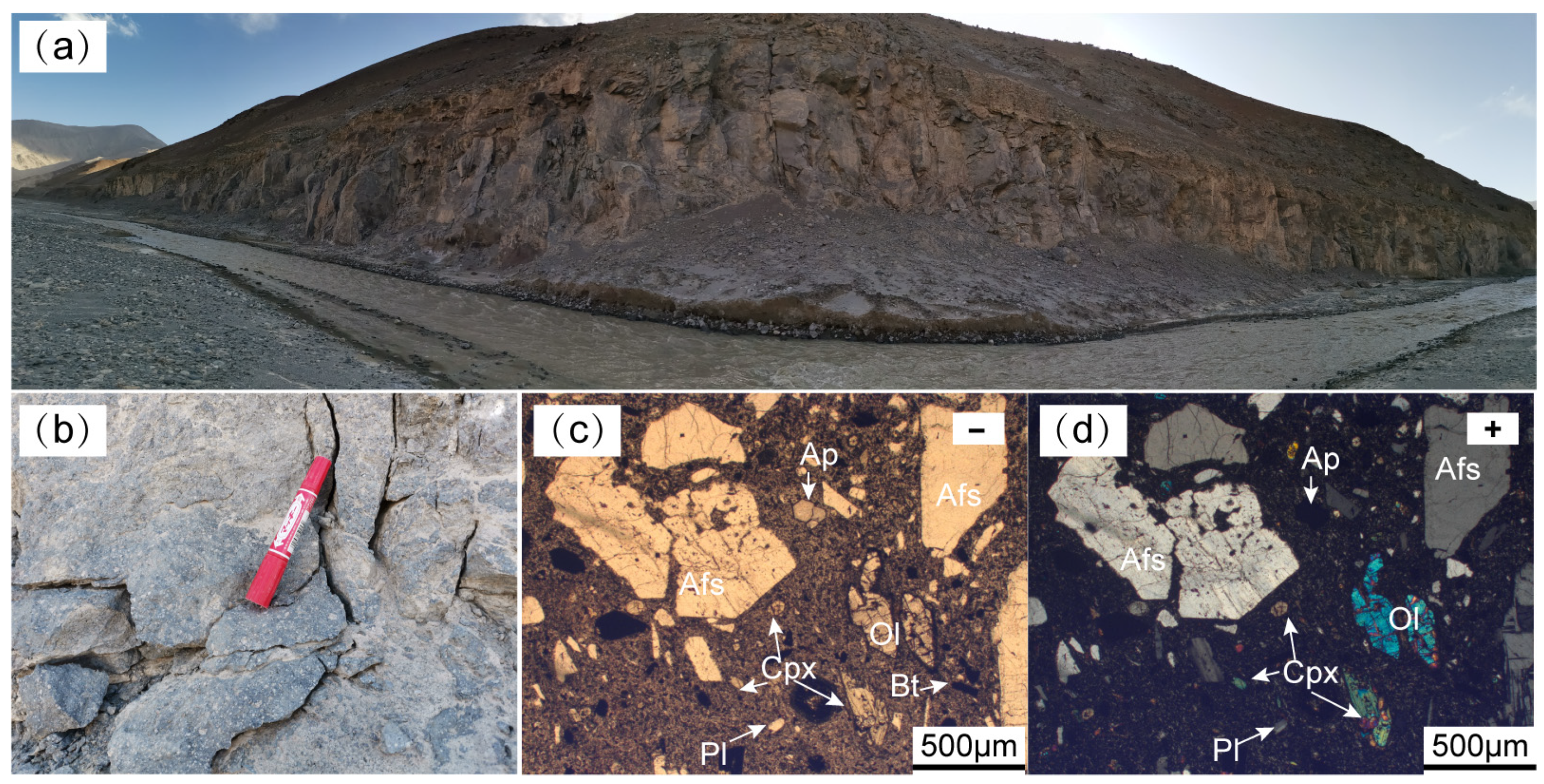

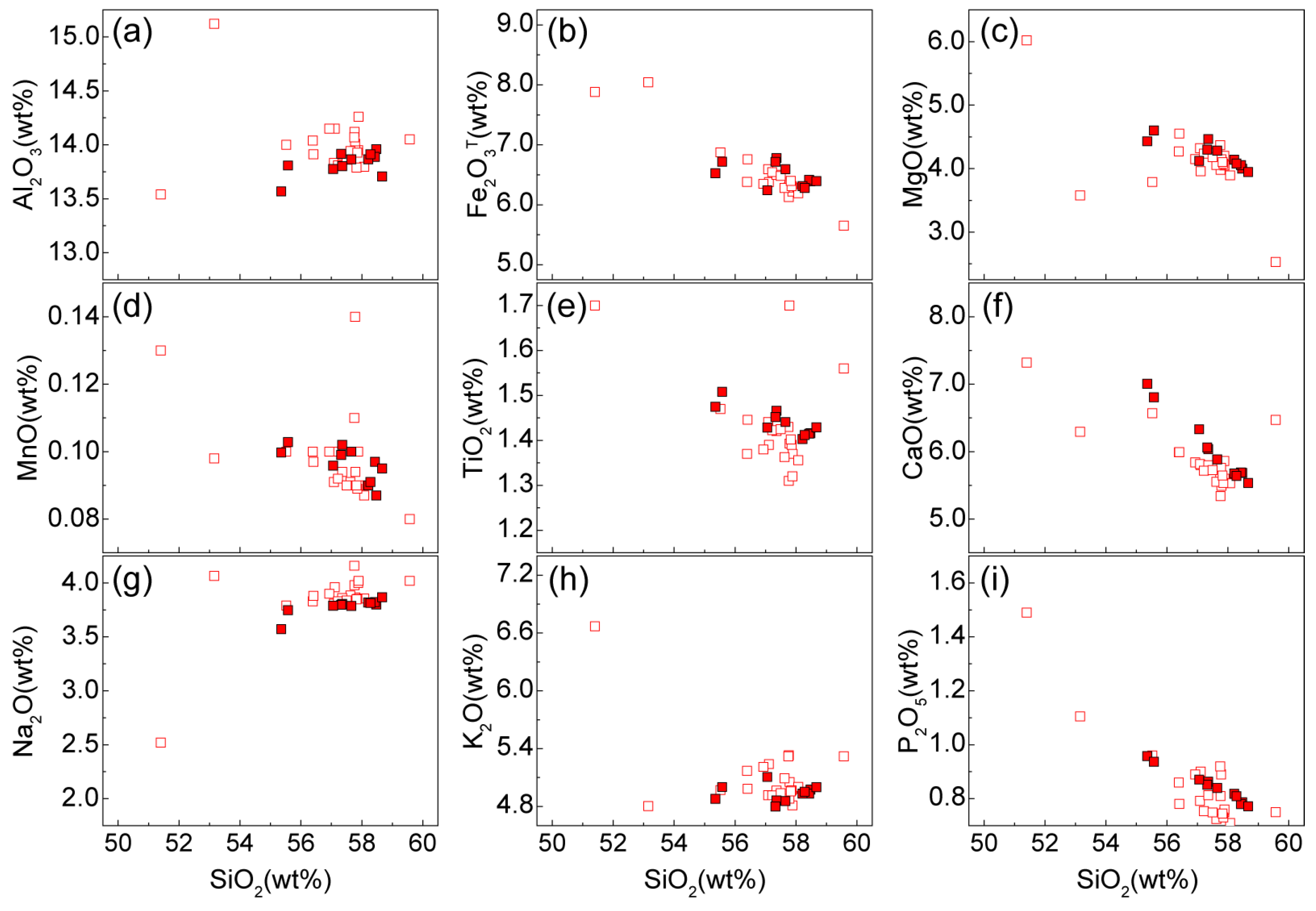
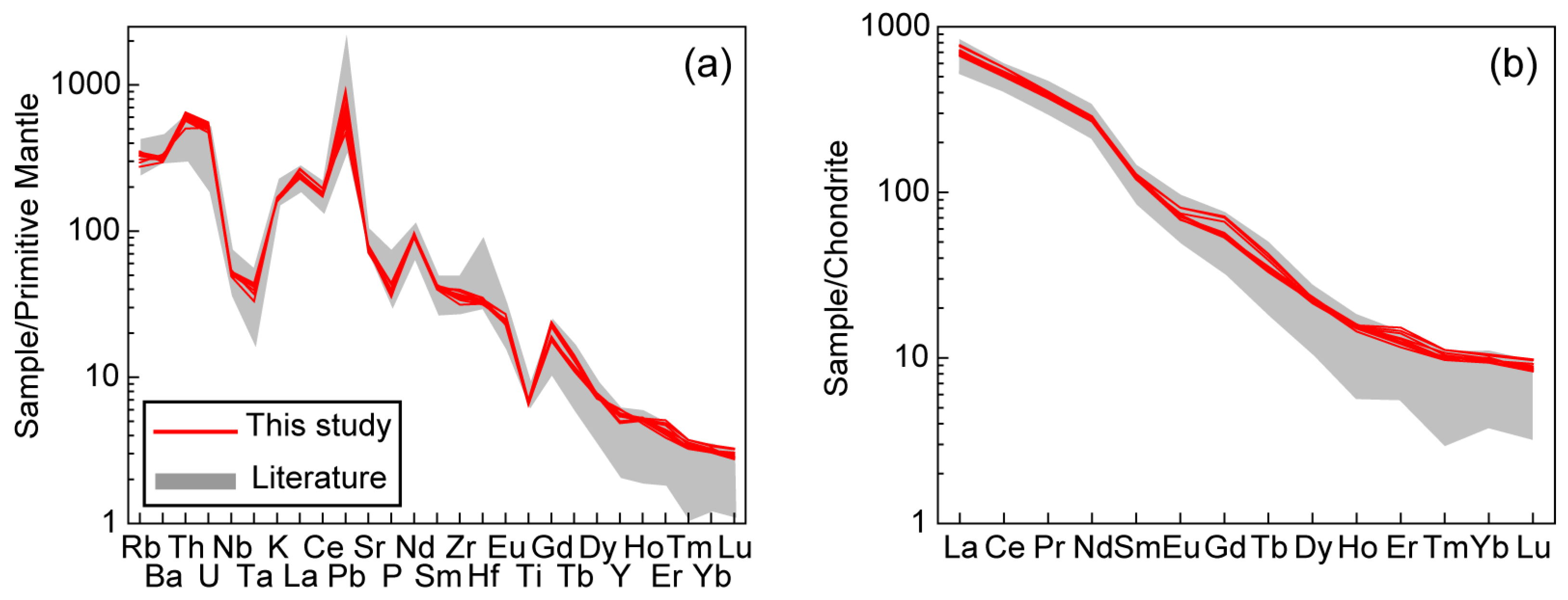
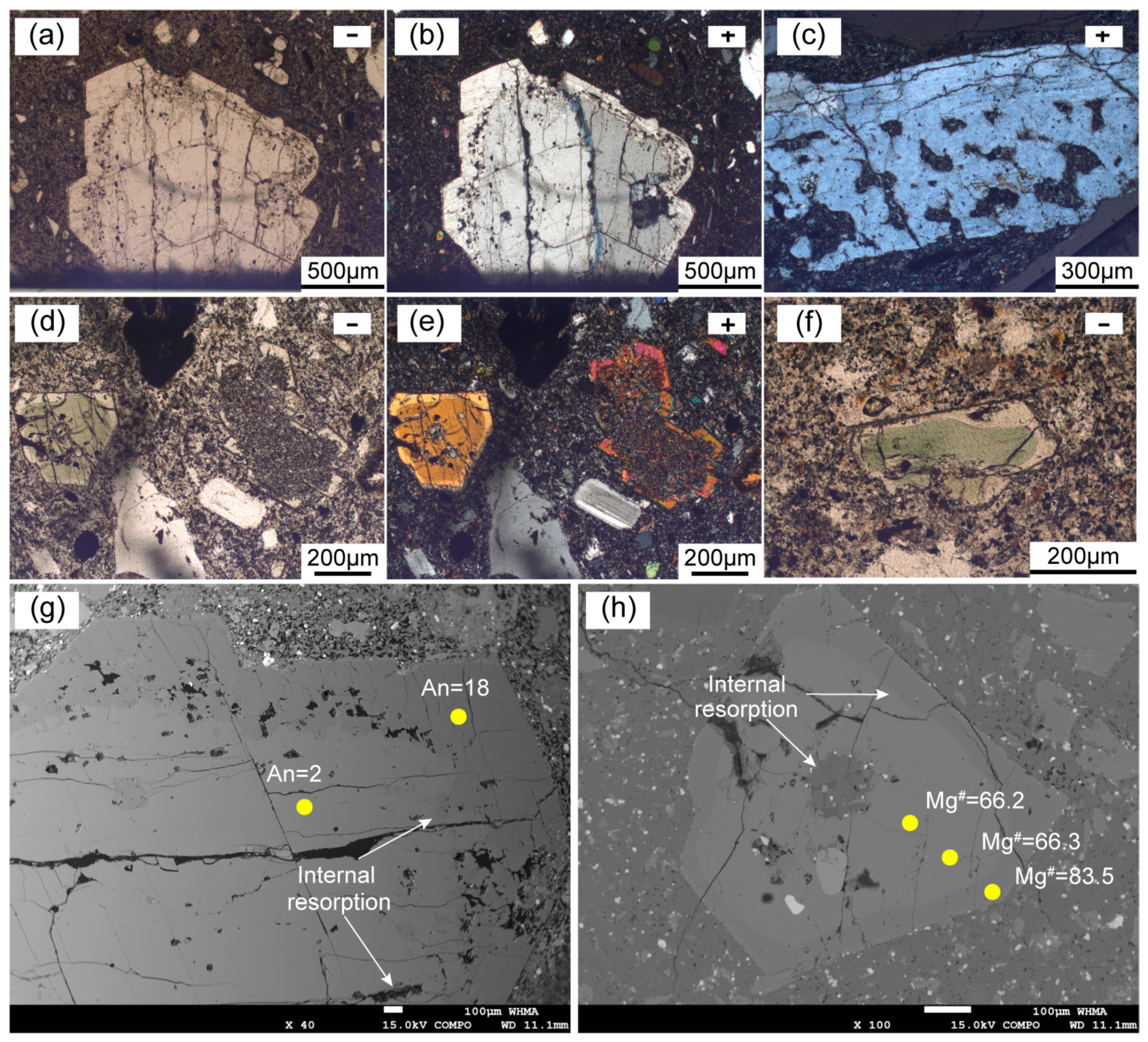

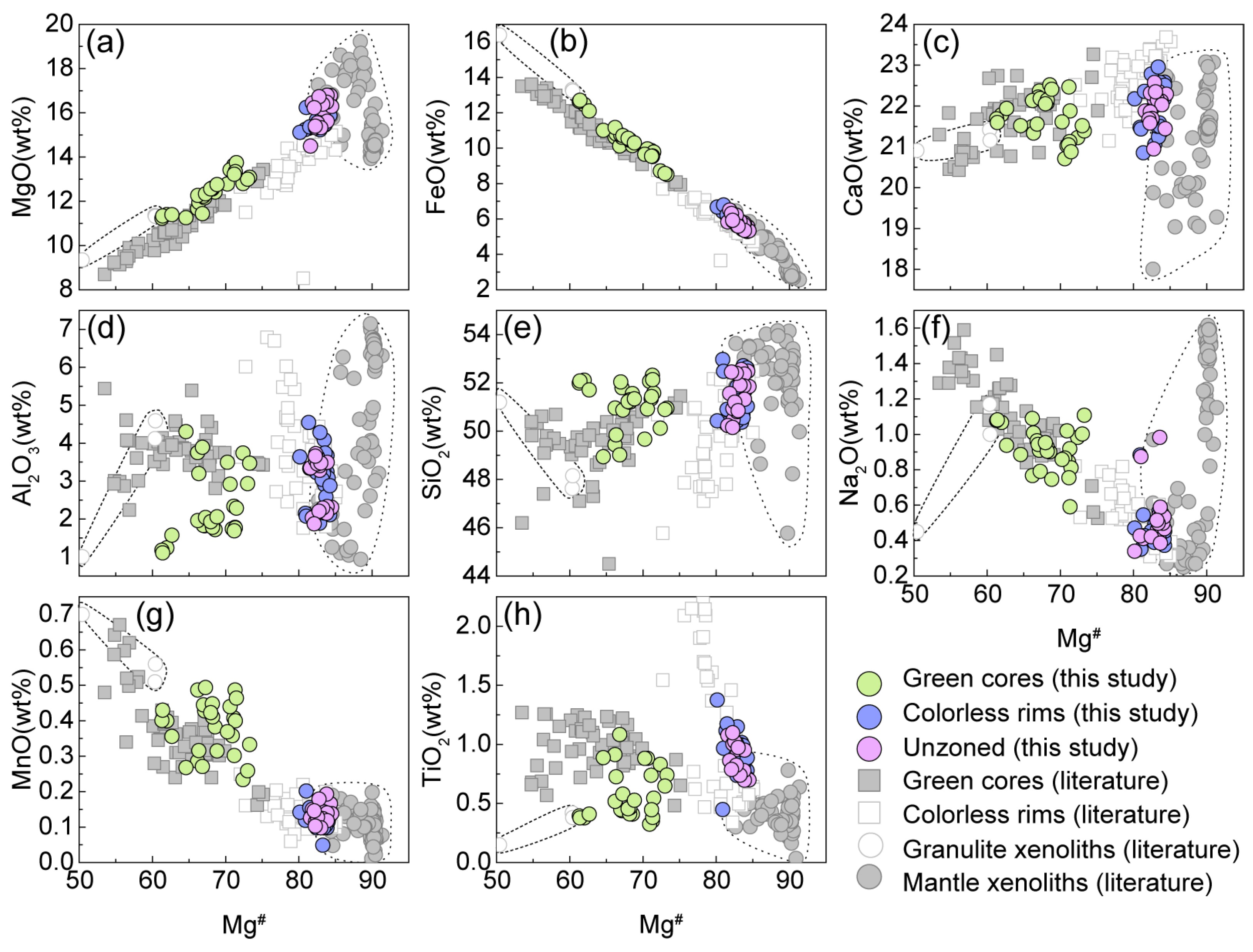
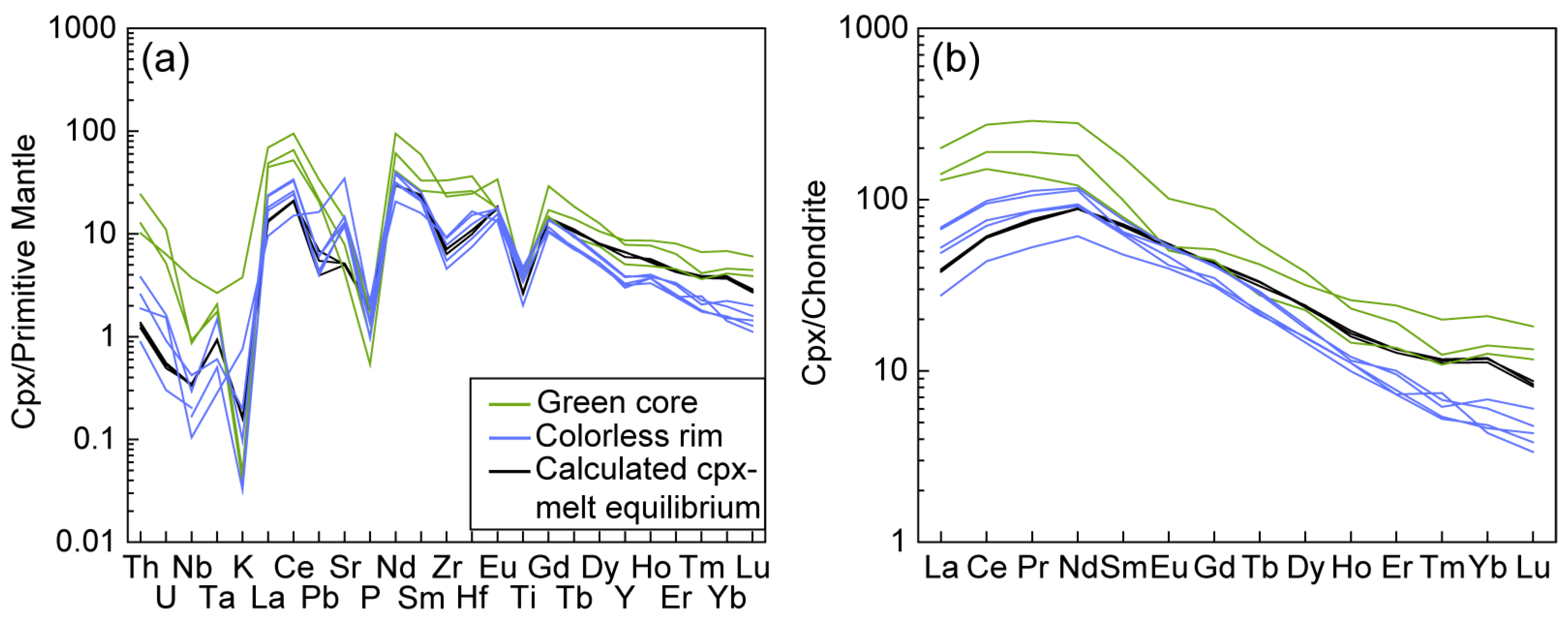
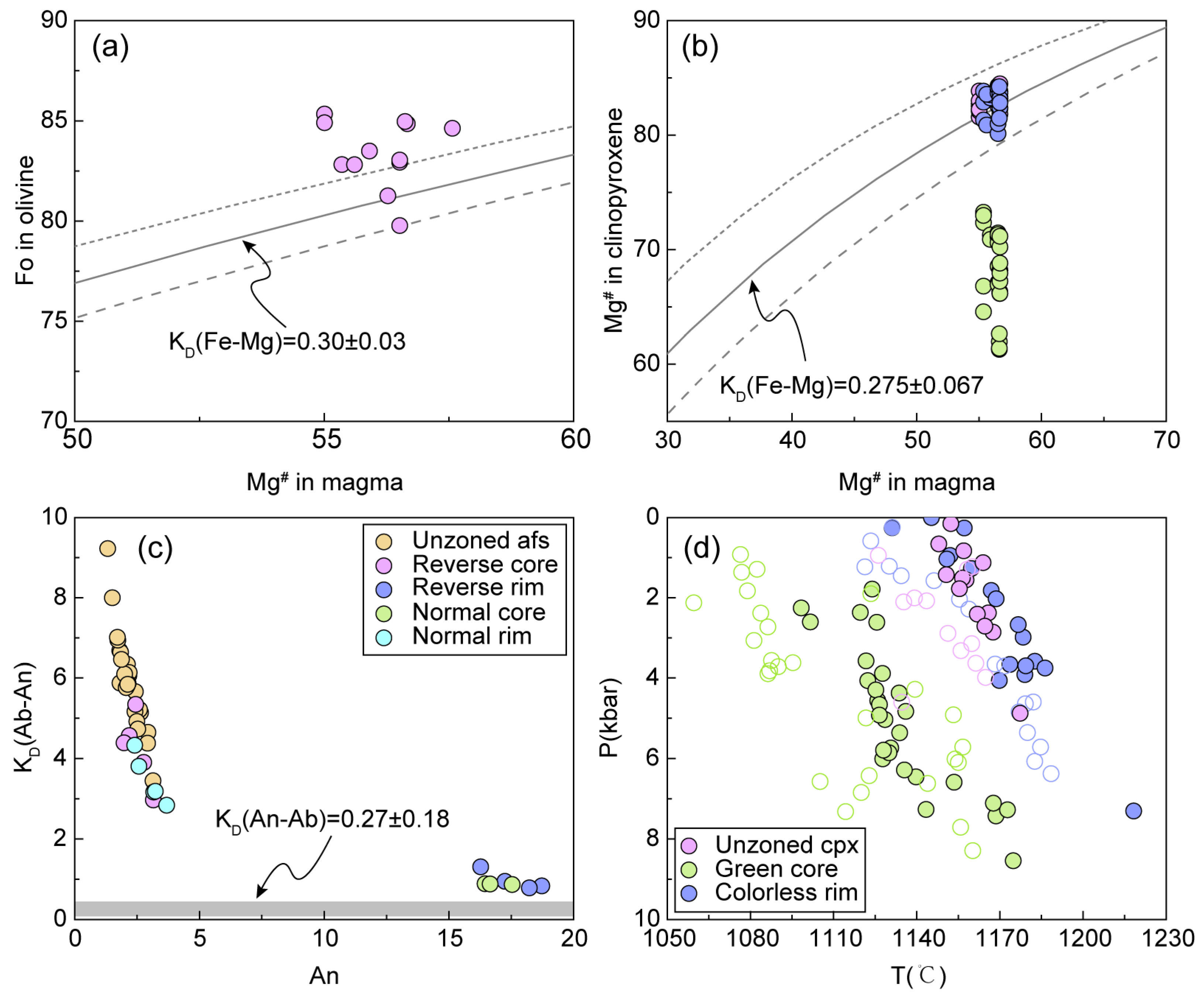
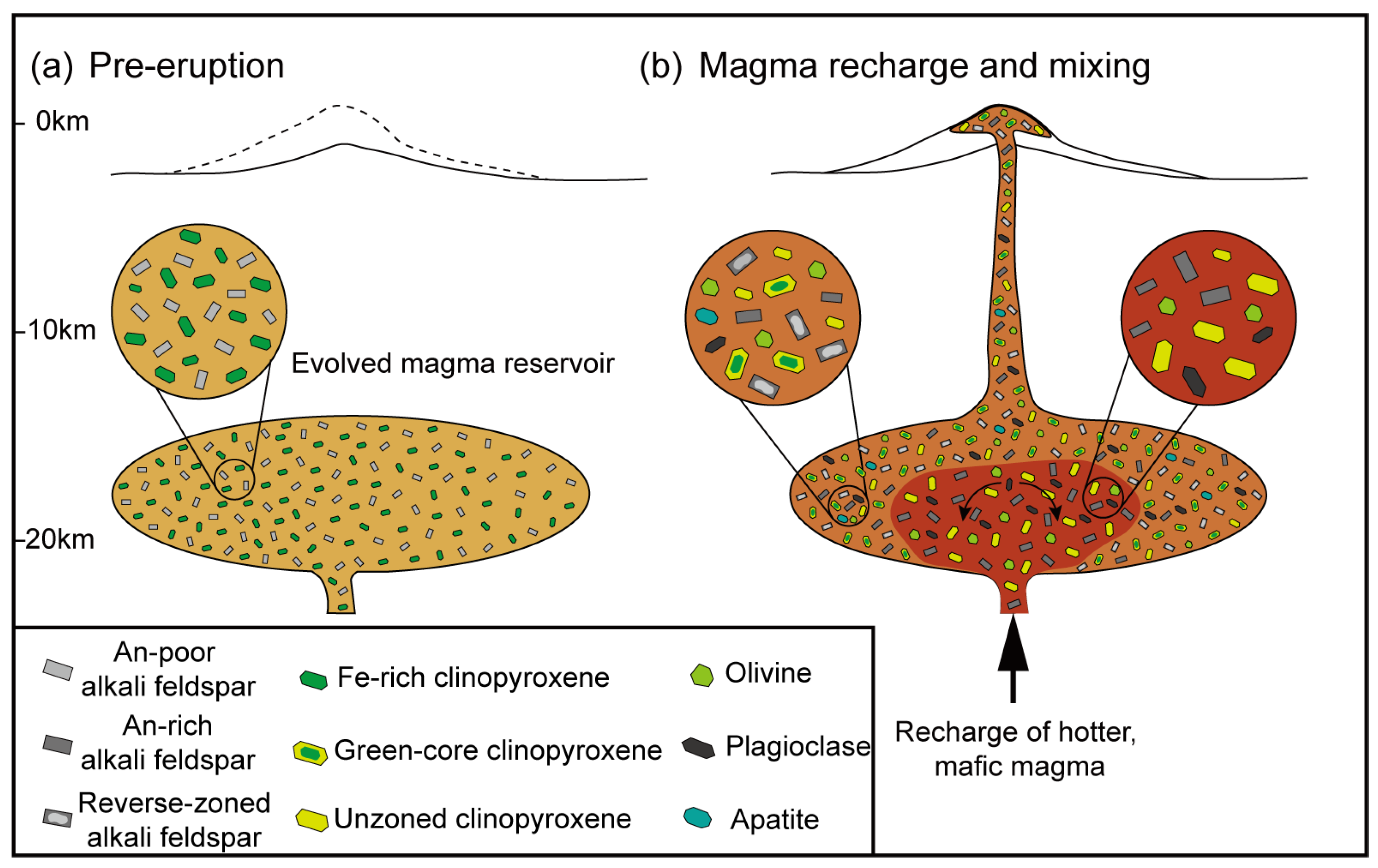
Disclaimer/Publisher’s Note: The statements, opinions and data contained in all publications are solely those of the individual author(s) and contributor(s) and not of MDPI and/or the editor(s). MDPI and/or the editor(s) disclaim responsibility for any injury to people or property resulting from any ideas, methods, instructions or products referred to in the content. |
© 2023 by the authors. Licensee MDPI, Basel, Switzerland. This article is an open access article distributed under the terms and conditions of the Creative Commons Attribution (CC BY) license (https://creativecommons.org/licenses/by/4.0/).
Share and Cite
Yang, W.; Zhao, B.; Yu, H.; Xu, J.; Wei, F.; Cui, X. Mineralogical Constraints on Magma Recharge and Mixing of the Post-Collisional Potassic Volcanic Rocks in Dahongliutan, NW Tibetan Plateau. Minerals 2023, 13, 1463. https://doi.org/10.3390/min13121463
Yang W, Zhao B, Yu H, Xu J, Wei F, Cui X. Mineralogical Constraints on Magma Recharge and Mixing of the Post-Collisional Potassic Volcanic Rocks in Dahongliutan, NW Tibetan Plateau. Minerals. 2023; 13(12):1463. https://doi.org/10.3390/min13121463
Chicago/Turabian StyleYang, Wenjian, Bo Zhao, Hongmei Yu, Jiandong Xu, Feixiang Wei, and Xiaoge Cui. 2023. "Mineralogical Constraints on Magma Recharge and Mixing of the Post-Collisional Potassic Volcanic Rocks in Dahongliutan, NW Tibetan Plateau" Minerals 13, no. 12: 1463. https://doi.org/10.3390/min13121463
APA StyleYang, W., Zhao, B., Yu, H., Xu, J., Wei, F., & Cui, X. (2023). Mineralogical Constraints on Magma Recharge and Mixing of the Post-Collisional Potassic Volcanic Rocks in Dahongliutan, NW Tibetan Plateau. Minerals, 13(12), 1463. https://doi.org/10.3390/min13121463





